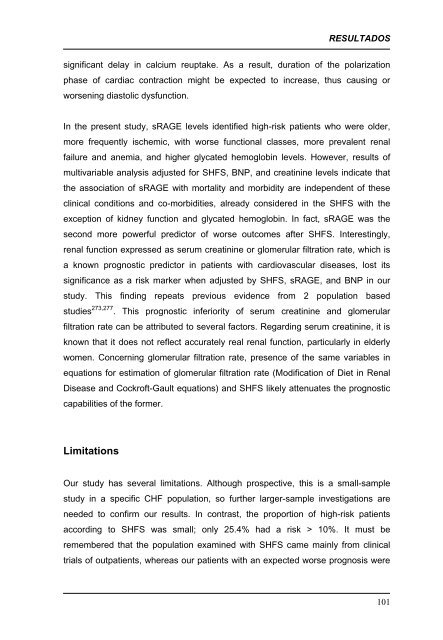INTRODUCCIÓN: REVISIÓN CRITICA DEL PROBLEMA
INTRODUCCIÓN: REVISIÓN CRITICA DEL PROBLEMA
INTRODUCCIÓN: REVISIÓN CRITICA DEL PROBLEMA
Create successful ePaper yourself
Turn your PDF publications into a flip-book with our unique Google optimized e-Paper software.
RESULTADOS<br />
significant delay in calcium reuptake. As a result, duration of the polarization<br />
phase of cardiac contraction might be expected to increase, thus causing or<br />
worsening diastolic dysfunction.<br />
In the present study, sRAGE levels identified high-risk patients who were older,<br />
more frequently ischemic, with worse functional classes, more prevalent renal<br />
failure and anemia, and higher glycated hemoglobin levels. However, results of<br />
multivariable analysis adjusted for SHFS, BNP, and creatinine levels indicate that<br />
the association of sRAGE with mortality and morbidity are independent of these<br />
clinical conditions and co-morbidities, already considered in the SHFS with the<br />
exception of kidney function and glycated hemoglobin. In fact, sRAGE was the<br />
second more powerful predictor of worse outcomes after SHFS. Interestingly,<br />
renal function expressed as serum creatinine or glomerular filtration rate, which is<br />
a known prognostic predictor in patients with cardiovascular diseases, lost its<br />
significance as a risk marker when adjusted by SHFS, sRAGE, and BNP in our<br />
study. This finding repeats previous evidence from 2 population based<br />
studies 273,277 . This prognostic inferiority of serum creatinine and glomerular<br />
filtration rate can be attributed to several factors. Regarding serum creatinine, it is<br />
known that it does not reflect accurately real renal function, particularly in elderly<br />
women. Concerning glomerular filtration rate, presence of the same variables in<br />
equations for estimation of glomerular filtration rate (Modification of Diet in Renal<br />
Disease and Cockroft-Gault equations) and SHFS likely attenuates the prognostic<br />
capabilities of the former.<br />
Limitations<br />
Our study has several limitations. Although prospective, this is a small-sample<br />
study in a specific CHF population, so further larger-sample investigations are<br />
needed to confirm our results. In contrast, the proportion of high-risk patients<br />
according to SHFS was small; only 25.4% had a risk > 10%. It must be<br />
remembered that the population examined with SHFS came mainly from clinical<br />
trials of outpatients, whereas our patients with an expected worse prognosis were<br />
101
















